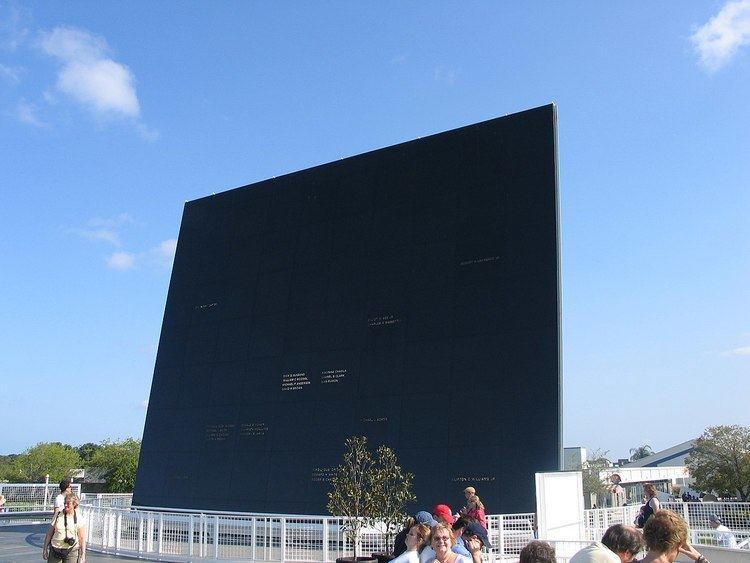Phone +1 866-737-5235 | ||
 | ||
Address Kennedy Space Center, Nasa Pkwy W, Merritt Island, FL 32953, USA Hours Open today · 9AM–6PMTuesday9AM–6PMWednesday9AM–6PMThursday9AM–6PMFriday9AM–6PMSaturday9AM–6PMSunday9AM–6PMMonday9AM–6PMSuggest an edit Similar Fallen Astronaut, Kennedy Space Center Vi, Rocket garden, United States Astronaut, Kennedy Space Center | ||
The Space Mirror Memorial, also known as the Astronaut Memorial, is a memorial on the grounds of the John F. Kennedy Space Center Visitor Complex on Merritt Island, Florida. It is maintained by the Astronauts Memorial Foundation, whose offices are located in the NASA Center for Space Education next door to the Visitor Complex. The memorial was dedicated in 1991 to remember the lives of the men and women who have died in the various space programs of the United States, particularly those of NASA. The Space Mirror Memorial has been designated a National Memorial by the U.S. Congress.
Contents
- Space mirror memorial
- Memorial elements
- Defunct sun tracking mechanism
- Memorial funding
- Honorees
- Astronauts Memorial Foundation
- References
In addition to 20 NASA career astronauts, the memorial includes the names of a U.S. Air Force X-15 test pilot, a U.S. Air Force officer who died while training for a then-classified military space program, a civilian spaceflight participant who died in the Challenger disaster, and an Israeli astronaut who was killed during the Columbia disaster.
Space mirror memorial
Memorial elements
The primary feature of the memorial is the Space Mirror, a large area of polished black granite, divided into 90 smaller panels. The names of the 24 astronauts who have died are scattered over the mirror, with names of astronauts who died in the same incident grouped on the same panel, or pairs of adjacent panels. The names are cut completely through the surface, exposing a translucent backing, and filled with translucent acrylic, which is then backlit with a combination of reflected sunlight (when available) and floodlights, causing the names to glow, and appear to float in a reflection of the sky.
Near the Space Mirror is a granite wall, bearing pictures and brief biographies of those listed on the Mirror. The Space Mirror Memorial was designed by Wes Jones of Holt Hinshaw Pfau Jones and was commissioned after he won an international design competition.
Defunct sun tracking mechanism
The memorial as built incorporated motors and jackscrews to constantly track the sun across the sky in both pan and tilt axes. Parabolic reflectors on the back side of the mirror would then direct the sunlight through the acrylic panels to brilliantly illuminate the honorees' names with sunlight. Supplemental floodlights were used when the sun was inadequate.
In 1997, the tracking system failed, allowing part of the monument to strike a steel beam on an adjacent platform. Insurance paid US$375,000 for repair work, but later, the mechanism again ground to a halt, due to further problems with the slewing ring.
Estimated repairs were on the order of US$700,000, and the Astronauts Memorial Foundation unanimously decided the money would be better spent on educational programs instead. The floodlights were repositioned and are kept burning 24 hours a day to illuminate the memorial.
Memorial funding
The Space Mirror Memorial was to be partially funded by the sales of "Space Shots" trading cards. An agreement for 25% of Space Shots profits, in exchange for guaranteeing a $160,000 loan. A projected $400,000 was owed to the Foundation, which was never paid.
The Space Mirror Memorial and the Astronauts Memorial Foundation are funded in part by a specialty vehicle registration plate issued by the state of Florida. Called the Challenger plate, it was first issued in 1987, and was the first specialty plate issued by the state. The third edition, introduced in 2004, includes Columbia in the text, and is now termed the Challenger/Columbia plate. The memorial cost US$6.2 million. License plates brought in $377,000 in 2009.
Honorees
Only those killed during human spaceflight missions or during training for such missions sponsored by the United States are eligible for inclusion in the memorial. For a comprehensive list of space disasters, see List of space disasters.
The people honored on the memorial are:
Astronauts Memorial Foundation
The president of the Astronaut Memorial Foundation was Stephen Feldman from 1999 to 2012. He was paid $303,000 annually. This was criticized as being the highest among 100 of Brevard County non-profits. His salary represented 18.3 percent of the fund's $1.8 million budget in fiscal year 2009. He defended his salary by saying that he was the sole fundraiser and the chief financial officer for the foundation.
Thad Altman became President and CEO of the Astronauts Memorial Foundation in August 2012. The Board of Directors include Eileen Collins - Chairman, Jack Kirschenbaum - Vice Chairman, Gregory H. Johnson - Treasurer, Sheryl L. Chaffee - Secretary.
